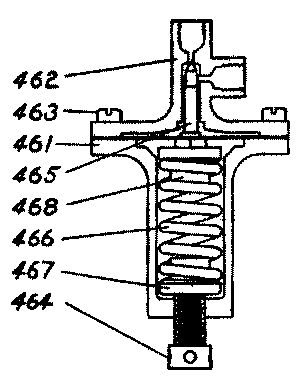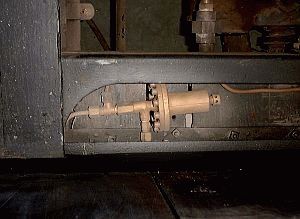|

At the top of the fuel pressure automatic is a
beryllium-copper disk or diaphragm. This diaphragm is clamped between
the two halves of the shell of the fuel pressure automatic (461 & 462). The
underside of the disk rests against a washer (468) which helps to keep the
heavy spring (466) centered while fuel pressure is
admitted to the top side of the disk. An adjusting screw (464) and
washer (467) allows for the spring tension against the disk to be set such that the diaphragm
doesn't start moving and compressing the spring until the fuel pressure reaches
140 PSIG.
Mounted to the opposite side of the
disk is the valve stem (465) which follows the position of the diaphragm. The valve body
is an integral part of the fuel pressure automatic's shell (462) as shown in
the diagram. Kerosene
(gasoline for the early model Stanleys that used gasoline for both the pilot
and burner) from the main burner pressure tanks is piped to the right port
of the burner fuel automatic. A line connected to the burner (main)
fuel tank is connected to the port at the top of the fuel pressure
automatic.
Normally the valve stem (465) is
pressed tight against the valve seat (462) and no fuel passes from the right
port through to the left port. When the fuel pressure exceeds 140 PSIG
(the normal set-point of the fuel pressure automatic) the diaphragm overcomes the spring force against it and
it moves slightly (down in the diagram) to compress the spring (466). As this motion happens
the valve stem (465) moves off the valve seat (462) opening up the passage
between the right port going to the fuel pressure tanks and the main fuel
tank. This action allows fuel to flow back to the tank and for the
system pressure to be maintained at 140 PSIG.
When the fuel pressure pressure drops the spring force
overcomes the fuel pressure acting on the disk and the diaphragm moves such
that the valve stem (465) returns to being seated and thus fuel will not pass though the
automatic. During normal operation the majority of the fuel pumped by
the power fuel pump is returned through the fuel pressure automatic to the
fuel supply tank.
Careful review
of the fuel piping system also will reveal that when the hand fuel pump is
used the fuel pressure automatic also limits fuel pressure. Generally
when firing up a Stanley and using the hand fuel pump it is only necessary
to keep the burner fuel pressure at no more than 130 PSIG as indicated on
the fuel pressure gauge. Pumping the pressure much higher only means
that most of the effort being put into pumping fuel is being wasted as it is
being returned to the supply tank by the fuel pressure automatic. |

